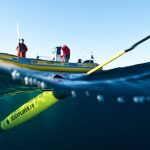 June 6, 2019 12:32 pm
Published by Climate Extremes
June 6, 2019 12:32 pm
Published by Climate Extremes
This observational study of radiative convective equilibrium finds that this equilibrium breaks down in areas of a few thousands kilometres on a side. This has implications cloud model simulations in climate models.
 June 5, 2019 3:47 pm
Published by Climate Extremes
June 5, 2019 3:47 pm
Published by Climate Extremes
In a world first, CLEX researchers have produced a 400-year-long record of El Nino activity. This gives us an entirely new insight into the behaviour of these high impact events and reveals unprecedented changes over the past 30 years.
 June 5, 2019 3:25 pm
Published by Climate Extremes
June 5, 2019 3:25 pm
Published by Climate Extremes
Large areas of northern Queensland experienced extreme rainfall and severe flooding in late January and February 2019. This briefing note examines the impacts and some of the likely causes of the event.
 June 5, 2019 1:32 pm
Published by Climate Extremes
June 5, 2019 1:32 pm
Published by Climate Extremes
CLEX researchers with the Bureau of Meteorology have created a new 20-year-long regularly updated precipitation dataset for Australia using 50 radar sites. This will allow researchers to examine the climatology of extreme events, follow cloud processes, estimate hail size, determine cloud top height and much more.
 May 31, 2019 2:30 pm
Published by Climate Extremes
May 31, 2019 2:30 pm
Published by Climate Extremes
CLEX researchers and colleagues have developed a downscaling methodology using the HiDRUS model that accurately projects future rainfall in 1km grids at six minute intervals. This will be a boon for urban planners who need to build infrastructure to cope with the different future heavy rainfall events that will occur in a changing climate.
 May 30, 2019 10:31 am
Published by Climate Extremes
May 30, 2019 10:31 am
Published by Climate Extremes
CLEX researchers and colleagues revisit the quasi-equilibrium analytical framework introduced by Comins and McMurtrie (1993) and explore the consequences of specific model assumptions for ecosystem net primary productivity (NPP).
 May 29, 2019 2:18 pm
Published by Climate Extremes
May 29, 2019 2:18 pm
Published by Climate Extremes
Using novel ocean glider technology, a team of researchers from France, Norway, and Australia observed small eddy-like lenses of cold water in July 2017 along the western Svalbard shelf in the Arctic.
 May 29, 2019 2:02 pm
Published by Climate Extremes
May 29, 2019 2:02 pm
Published by Climate Extremes
New work published in Nature Communications develops a correction method that ensures the probability of climate extremes in the model simulations are consistent with real-world observations. In addition, it also corrects the rate of the long-term changes and the inter-annual variability so that it is consistent with observations.
 May 24, 2019 1:25 pm
Published by Climate Extremes
May 24, 2019 1:25 pm
Published by Climate Extremes
New CLEX research finds land cover misclassifications over South East Asia based on remote sensing products have negligible impact on the outcomes of climate model experiments. However, land cover experiments that incorporate uncertainties must use large numbers of simulations to get robust results for rainfall and air temperature.
 May 23, 2019 12:47 pm
Published by Climate Extremes
May 23, 2019 12:47 pm
Published by Climate Extremes
CLEX researchers find strong correlation between ozone hole size and Australian summer temperatures. While there is no causal link between the two, the changes are driven by the same source - ocean temperatures.










